Government must invest in Talanta Rally Academy

Esapekka Lappi navigated by Janne Ferm racing on Hyundai i20 at Soysambu stage during World Rally Championships Safari Rally Kenya on June 24,2023.
What you need to know:
- Last weekend's RX attracted a healthy field of 34 drivers of all ages and experience.
- The emerging female drivers, led by Maxine Wahome, have shown keen interest in the sport, which needs a proper strategic plan for revival.
There were 104 seeded rally drivers in Kenya in 1992 compared to 24 in 2024, a huge drop and signs of a bleak future. Drivers had every reason to compete in motorsport to either safeguard their seeding points or aspire to increase them.
The inspirational aspect has been missing recently, even with the return of the Safari Rally to the World Rally Championship (WRC) in 2021 after 19 years.
There are only a handful of Rally 2 cars in Kenya, predominantly Subaru and Mitsubishi models, which are still very competitive, but the prohibitive cost of rallying has kept many drivers away, resulting in a dwindling number of participants in the Kenya National Rally Championship (KNRC) which has recently been attracting up to a dozen drivers only from a high of 30 and above.
But while the Safari was once a dream of every rally driver to compete in, preferences are changing amongst Kenyans, especially young drivers who banter for hours on end about who owns a well-tuned car with the highest turbo boost and loudest anti-lag noise in town. They sometimes take their fights on open roads or abandoned airstrips.
It is about time motorsport authorities either revived or expanded the competition format to fit the financial ability of all drivers. It is about time the government actualised the Talanta Rally Academy.
RX events
One of the solutions is the RX events, where you don't need to have a car of your own to race. Friends can pool resources and share the same machine provided it meets safety standards and enter the RX, a circuit racing event introduced two years ago by Carl Tundo, the five-time Safari Rally champion, who teamed up with his navigator Tim Jessop and father Frank Tundo to start this racing competition in 2022.
Last weekend's RX event at the Kasarani Super Special Stage reaffirmed that the rally scene has potential for growth back to the golden era of the 90s when Africans with disposable income started rallying and joined Whites and Asians — a trend which continued up to 2019.
Last weekend's RX attracted a healthy field of 34 drivers of all ages and experience.
Many of them are young and ready to take off following the impressive performance at the Kasarani Super Special Stage, where wet conditions separated the boys from men and identified the talent in motorsport in Kenya.
The drivers were in teams of four composed of junior, female, active senior and legend, sharing the same car in each competition round from qualifiers on Saturday and finals on Sunday, a cost-effective solution to lack of resources.
The youth, some of them not legally licensed to drive on open roads like Munene Gitau, were bubbling with enthusiasm, keen to learn from the active and legendary drivers who honed their careers in all sorts of conditions like Frank Tundo, an accomplished driver of the old format Safari Rally of the 70s and 80s.
Proper strategic plan
The emerging female drivers, led by Maxine Wahome, have shown keen interest in the sport, which needs a proper strategic plan for revival.
It is no secret that rallying has gone into hibernation partly due to economic factors but a lack of innovations to serve a growing population of drivers who are not necessarily keen on competing in the KNRC.
The KNRC was the epitome of rally sport until Covid-19 struck, with fewer participants recorded in the last three years.
The absence of a title sponsor, after long-time KNRC supporter the KCB Bank withdrew its support and the departure of two teams from Kabras and Multiple Hauliers, left the competition poorer.
The RX and autocross offer a clear direction for the sport, which must spread from the plateau following the preferences of a new class of competitions recently.
The RX's format is a nostalgic journey back to a glorious past when motorsport activities started with bikes and circuit racing at Gilgil, Langalanga Nakuru and Embakasi circuits. The government should also come up with mitigating solutions to return rallying back to its pedestals by unveiling the structures of the Talanta Rally Academy, unveiled with pomp on the eve of this year's WRC Safari Rally, but nothing has been reported on any progress of the academy so far.
This academy should not exist merely by name. It must be a proper rally school like those in Finland, the Mecca of rallying, which are managed by qualified instructors from the famed "Flying Finns" stable of Rauno Aaltonen, Juha Kankkunen and Tommi Makinen.
They offer the best instructions and produce the best drivers.
The late Jonathan Toroitich, who used to crash or damage his cars in his early driving days, is a good example. He decided to seek advanced driving in Finland as a rookie and returned as an equal, even amongst the best, after only a few weeks in 1994.
Toroitich started winning local rallies and had by 1997 advanced to a ‘B’ seed driver, which was the second tier from the top. He finished fifth in that year's Safari and won the KNRC to become only the second black African driver to win the national title after Patrick Njiru, who won four following assistance from Subaru's parent company in Japan.
It took 24 years for another black African driver to win a KNRC since Njiru in 1999 when Jeremiah Wahome won the Machakos Rally last year.
The ministry should provide information on how rally drivers will be trained to global standards and who will foot the tab.
What is a rally school in Finland? Rallying in the Scandinavian country is taken very seriously with structures which rival faculties of mechanical engineering in universities. Training a rally driver is also not cheap. It costs Sh1.28 million to train a rally driver for two days. This excludes a deposit of Sh480,000 for damages. The instructors concentrate on techniques of control of a vehicle at high speed, driving on ice, driving techniques for 4-wheel drive, optimal use of traction control (ESP, ASR and ABS) at high speed, basics of driving racing lines, cornering, braking and braking points.
Rally professional instructors are not new in Kenya.
Tapio Laukunen is one of the most experienced rally instructors in the world. He won the 2015 Kenya national title during his call of duty to train the Rai family drivers and Manvir Baryan, who transformed from a have-been to a world-class driver.
Onkar Rai drove a VW Polo to seventh in the 2021 WRC Safari Rally, while Baryan won the Africa title twice.
Laukunen, who also managed McRae Kimathi in the 2022 Junior World Rally Championship says he first evaluates a driver's competence in his website.
"Depending on your competition level, we must go through weak areas of your driving to start with. If you are a beginner, it’s quite easy because we must start with basic things," Laukunen says.
"National drivers are the most common customers for me. Drivers at the world championship level have noticed that you learn new tricks every day, that’s why I’m dealing with them as well."
Njiru, Ian Duncan, Baldev Chager, Tundo and Azar Anwar are good instructors. But their services are not cheap. But this is the premium the government must pay if the Rally Academy is to succeed in its mission and produce proper Returns on Investment. You must also have proper rally cars.





